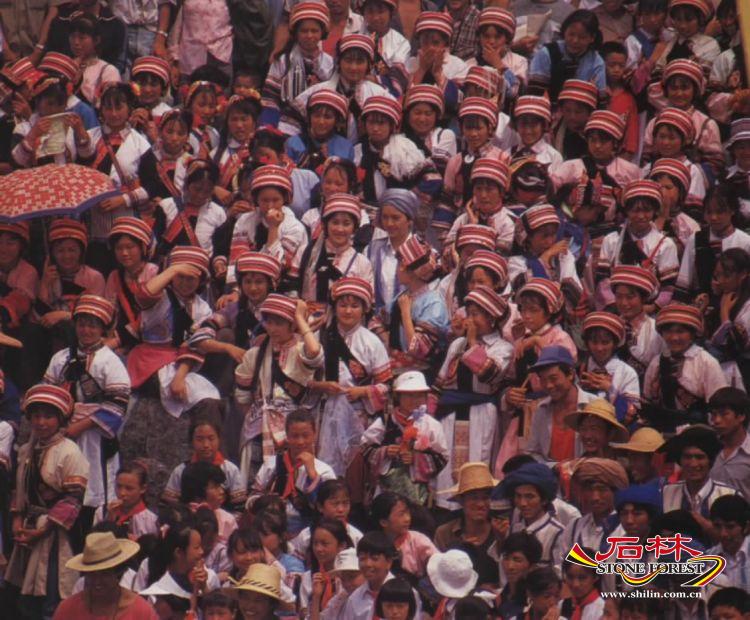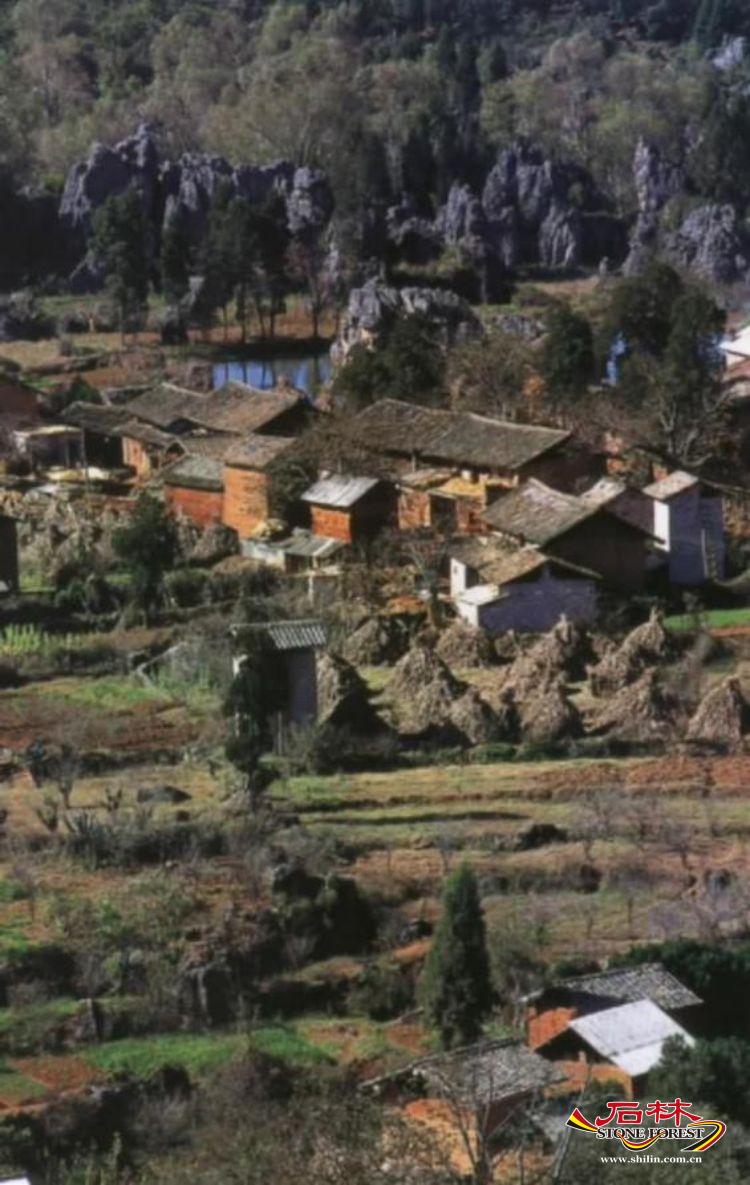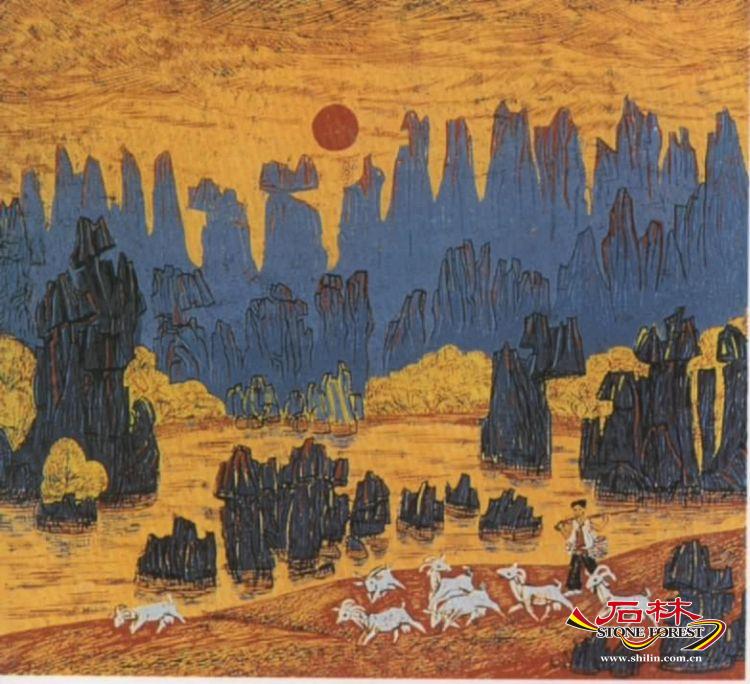- Children from Shijin Kindergarten Made a Study Trip to Shilin UGGp
- Have a spring date with Shilin flowers
- Call for hosts of the 12th International Conference on UNESCO Global Geoparks in 2027
- Call for applications: UNESCO Global Geopark Mentorship Exchange
- Representatives of Changshan Aspring UGGp Visited Shilin UGGp
- Shilin UGGp Visited Xingyi Aspiring UGGp
- Children from Peiqi Kindergarten Visited Shilin UNESCO Global Geopark
Human History, Activities and Cultural Landscape
The Lunan basin, on the west side of the Stone Forest Geopark, is characterized by flat topography, abundant water resource and mild climate, therefore, has been occupied by human beings since long before.
The history of human occupation in the Shilin area may trace back to Paleolithic Age. Seven archeological sites of Paleolithic Age have been found along the banks of Bajiang River, they are also important Paleolithic archeological sites of the whole Yunnan province. Archeological site of Neolithic Age was found in a cave two kilometers southwest of Maoshezu village, northeast part of the park. Copper dagger-axes and swords of Shang Dynasty (B.C 1,700-1,100) and coins of West Han Dynasty (B.C 206-25) were excavated in an old Yi people’s village in the northeastern part of the Geopark. Rock paintings of 1,700 years old depicting human image, dancing, hunting, and star chart were found in the Liziyuanqing Stone Forest.

Local Sani people
Sani people, a branch of Yi nationality, is believed the descendants of the ancient Shiqiang tribe from northwest China and the Han people from the east hinterland (then Chu state, Zhou Dynasty). One of the earliest written records of local history is Geography, Yuan Dynasty, in which it is described: “The town named Salu in Lunan prefecture (locally called Ludian) was built and settled for generations by the Lomeng tribe who are the descendants of ancient local tribe”. Lomeng tribe mentioned in the description refers to the ancient clan tribes of various sizes. They are the ancestors of Yi people of Shilin area.

Rural house

Yi people’s village
There are 45 villages of various sizes in the Geopark with a population density of 130 persons/km2. Yi people, consists of branches of Sani, Black Yi, White Yi, Yiqin, Axi, Ayizi, account for 43.2% of the total population. There are some villages in the southern part of the Geopark settled almost all by Yi people. In addition, there are some twenty other nationalities in the Geopark such as Han Nationality, Miao Nationality, Zhuang Nationality, Bai Nationality, Hui Nationality, Hani Nationality, Wa Nationality, Dai Nationality, Yao Nationality, Lahu Nationality, Shui Nationality, Lisu Nationality, etc.
From Paleolithic Age to Copper Age, particularly over the last two thousand years, human activities extended progressively from initially the riverbank to the whole basin, then the lakeshore, and finally the karst hilly country. Long term settlement in a karst environment have not only made the karst an important part of local Yi people’s life, but also enabled the Yi people to develop a lifestyle suitable and harmonious to the karst environment. Also, stone forest landscape has become an inseparable part of Yi people’s culture, including religion, festival, song and dance, residential buildings, etc.
There is a long standing Sani legend about the origin of the Stone Forest, say that in ancient time the Sani hero Jinfenroga wanted to build a dam for his fellow subjects, so he stole the magic “mountain moving order” and the “mountain driving whip” and, in
a night, drove the stones from Luliang in the south to the Nanpan River of Yiliang in the north, on his way passing through the Shilin area it was nearly dawn time, and his heroic undertaking was spoiled by the magic rooster crow. The stones stayed at Shilin and became the Stone houses. In their traditional Mizhi festival, stone tiger is also the subject to be worshiped.
Mizhi forest village
A patch of virgin forest is usually retained and protected in a slope behind each Yi people’s village. This virgin forest, called Mizhi forest, plays a role in water resource conservation and is the place for villagers to hold Mizhi festival. In front of the village is a water pool, either natural karst lake or man modified pond. Other lands, basin and gentle slope, are farmed for agriculture. This typical “ecological village” represents a land use pattern that harmonizes the people and the nature, reflecting local people’s philosophy of integrating forest, water resource, farmland, residence and religion.
Mythology attached to Stone Forest
To the local Sani people, the many peculiar stone pillars and stone forests are not just beautiful scenery, but also the tangible embodiments of beauty, freedom, happiness, honesty and good. The stone pillar Ashima is the incarnation of the industrious, courageous and intelligent Sani girl who, as described in the Sani epic Ashima, fought against the evil together with her boyfriend Ahei in pursuing freedom and happiness, and finally turned into the perpetual stone pillar Ashima mirroring her pretty figure vividly. Scenes like these that contain Sani people’s myth and legend are too many to be mentioned in the Stone Forest.
Colorful ethnic costume and handicraft
Black is one of Yi people’s favorite colors and is reflected in their traditional costume, particularly for mid-old aged people, black is the dominant color of their clothes. In the past, Black Yi, a branch of Yi nationalities, also enjoyed a higher social position. Ahei (a swarthy Sani boy) is their legendary hero.
Stone forest coincides in color with Yi people’s aesthetic inclination, many place names in Yi language contain “black” meaning: “Lunan” means “black stone terrain”, “Naigu Stone Forest” means “black stone forest ”, so on and so forth.
Yong Sani people’s costume is brighter and in more colors, besides black, there are white, pink, yellow, etc. The yang Sani girl’s headdress is impressive, not only beautiful ornament characterized by delicate embroidery, but also indicating the girl’s marital status: single, engaged or married.
Sani people’s handicrafts include embroidery, stone curving, ethnic musical instruments, etc.

Colorful ethnic costume
Ethnic festival
Torch Festival: held in the June 24th of Yi people’s lunar calendar each year, during the day, people come from near and afar, get together at a extensive karst depression. In the daytime, Groshanhao, a kind of trumpet, is resonant. Dasanxian, a three stringed musical instrument, is melodious. Traditional festival activities like wrestling, bullfighting, etc. are held. At night numerous Sani people, hand in hand and accompanied by Dasanxian, will sing and dance heartedly throughout the night around a huge camp fire. It is also a good time for the Sani youth to look for their sweethearts. In the night, all the Yi villages will light torches and all the people will walk through hills and fields in on order to expel injurious insects and to ensure a good harvest and the safety of everyone and their livestock.
Mizhi Festival: it is a traditional festival with tint of primitive religion, held from the first “Mouse day” to “Horse day” in December according to Yi’s calendar. Mizhilin, conserved virgin forests due to religious belief, are the localities to hold the festival. During the time, worship activities are held to pray for lush forest, favorable climate, flourishing populations of both people and livestock, and good harvest. There is a god team consisting of Ancestor God, Land God, Forest God, etc. played by the villagers and headed by a senior villager. In the festival they review their ancestor’s life, hunting, wrestling, playing, and so on. Also, ethnic ethics, moral concepts and village rules are studied and pass down.
Language and folk art
Yi people have developed their own oral and writing language since long ago. Yi language was even introduced to the west one hundred years ago. Paul Vial, a French missionary, lived in Shilin area for 31 years from the end of nineteenth century to the early twentieth century. Besides missionary work, he compiled French –Luo(Yi) Dictionary, History and Religion of Luo People, and Study on Luo Language, etc. All are earliest and important research documents of Yi nationality and their language.

Local farmer’s painting
